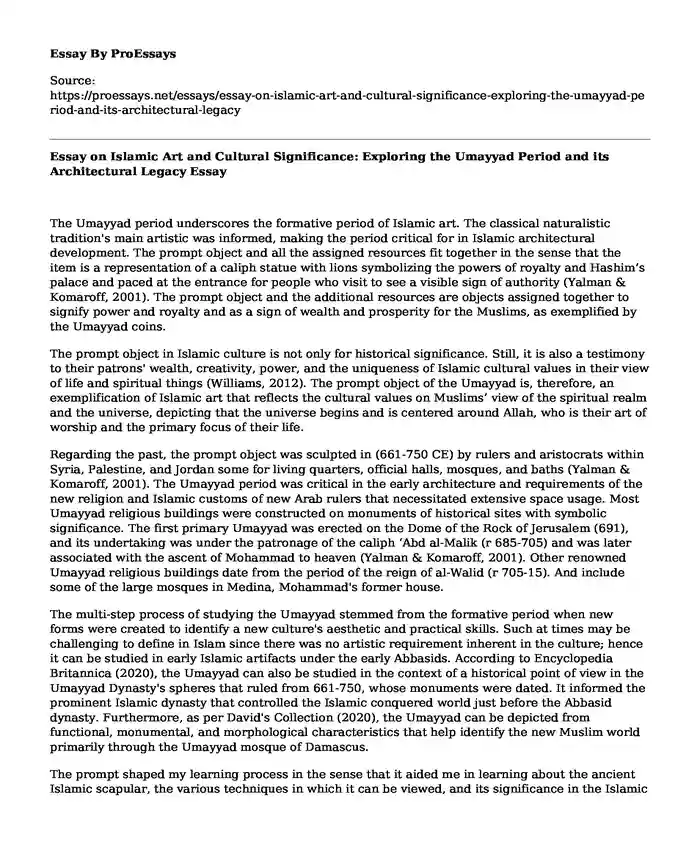The Umayyad period underscores the formative period of Islamic art. The classical naturalistic tradition's main artistic was informed, making the period critical for in Islamic architectural development. The prompt object and all the assigned resources fit together in the sense that the item is a representation of a caliph statue with lions symbolizing the powers of royalty and Hashim’s palace and paced at the entrance for people who visit to see a visible sign of authority (Yalman & Komaroff, 2001). The prompt object and the additional resources are objects assigned together to signify power and royalty and as a sign of wealth and prosperity for the Muslims, as exemplified by the Umayyad coins.
The prompt object in Islamic culture is not only for historical significance. Still, it is also a testimony to their patrons' wealth, creativity, power, and the uniqueness of Islamic cultural values in their view of life and spiritual things (Williams, 2012). The prompt object of the Umayyad is, therefore, an exemplification of Islamic art that reflects the cultural values on Muslims’ view of the spiritual realm and the universe, depicting that the universe begins and is centered around Allah, who is their art of worship and the primary focus of their life.
Regarding the past, the prompt object was sculpted in (661-750 CE) by rulers and aristocrats within Syria, Palestine, and Jordan some for living quarters, official halls, mosques, and baths (Yalman & Komaroff, 2001). The Umayyad period was critical in the early architecture and requirements of the new religion and Islamic customs of new Arab rulers that necessitated extensive space usage. Most Umayyad religious buildings were constructed on monuments of historical sites with symbolic significance. The first primary Umayyad was erected on the Dome of the Rock of Jerusalem (691), and its undertaking was under the patronage of the caliph ‘Abd al-Malik (r 685-705) and was later associated with the ascent of Mohammad to heaven (Yalman & Komaroff, 2001). Other renowned Umayyad religious buildings date from the period of the reign of al-Walid (r 705-15). And include some of the large mosques in Medina, Mohammad's former house.
The multi-step process of studying the Umayyad stemmed from the formative period when new forms were created to identify a new culture's aesthetic and practical skills. Such at times may be challenging to define in Islam since there was no artistic requirement inherent in the culture; hence it can be studied in early Islamic artifacts under the early Abbasids. According to Encyclopedia Britannica (2020), the Umayyad can also be studied in the context of a historical point of view in the Umayyad Dynasty's spheres that ruled from 661-750, whose monuments were dated. It informed the prominent Islamic dynasty that controlled the Islamic conquered world just before the Abbasid dynasty. Furthermore, as per David's Collection (2020), the Umayyad can be depicted from functional, monumental, and morphological characteristics that help identify the new Muslim world primarily through the Umayyad mosque of Damascus.
The prompt shaped my learning process in the sense that it aided me in learning about the ancient Islamic scapular, the various techniques in which it can be viewed, and its significance in the Islamic historical, cultural, and religious context. Besides, the prompt has also shaped my learning process in the spheres of the Islamic Umayyad dynasty, coupled with early Islamic architectural developments and the significance of each art and symbol in their cultural values of lives and spiritual beliefs. Conversely, the prompt will significantly impact how I look at other works in the future by focusing on every vital detail stemming from the cultural, religious, and artistic message, especially from the arts. Besides, I would yearn to know more about other artistic achievements in the Islamic culture and different cultures and religions, coupled with other desert-fortified arts and the meanings of every decoration in them.
References
Desert palace. (2020). In Encyclopedia Britannica. https://www.britannica.com/topic/desert-palace
The religious prohibition against images - The David collection. (2020). Davids Samling. https://www.davidmus.dk/en/collections/islamic/cultural-history-themes/image-prohibition
Williams, E. (2012, October). Baths and bathing culture in the Middle East: The hammam |Essay | The Metropolitan Museum of Art | Heilbrunn timeline of art history. The Met’sHeilbrunn Timeline of Art History. https://www.metmuseum.org/toah/hd/bath/hd_bath.htm
Yalman, S, & Komaroff, L. (2001, October). The art of the Umayyad period (661–750). TheMet’s Heilbrunn Timeline of Art History. https://www.metmuseum.org/toah/hd/umay/hd_umay.htm
Cite this page
Essay on Islamic Art and Cultural Significance: Exploring the Umayyad Period and its Architectural Legacy. (2023, Dec 13). Retrieved from https://proessays.net/essays/essay-on-islamic-art-and-cultural-significance-exploring-the-umayyad-period-and-its-architectural-legacy
If you are the original author of this essay and no longer wish to have it published on the ProEssays website, please click below to request its removal:
- Book Review Example: Skilled Exercises for Preachers
- Eras of Western Music - Paper Sample
- Research Paper on Gender Role in "The Little Mermaid"
- Essay Example on The Beatles: The Greatest Rock and Roll Band of All Time
- The Book of Amos: Ancient Prophecy & Posthumous Editing - Essay Sample
- Paper Example on My Heritage, My Pride: Crafting an Identity From a Faded Culture
- The 5 Pillars of Islam: Foundations of a Faith - Free Paper Sample







